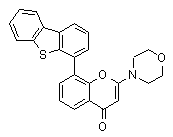All AbMole products are for research use only, cannot be used for human consumption.

NU7441 (KU 57788) is a potent and selective DNA-dependent protein kinase (DNA-PK) inhibitor with IC50 values of 14, 1700, 5000, >100000 and >100000 nM for DNA-PK, mTOR, PI 3-K, ATM and ATR respectively. NU7441 strongly inhibited DNA-PK in cell lines (IC(50) = 0.3 μM) but only weakly inhibited PI3 K (IC(50) = 7 μM). The only available anti-phospho-DNA-PK antibody also recognised some phosphoprotein targets of ATM. NU7441 (KU 57788) caused doxorubicin- and IR-induced DNA DSBs (measured by γ-H2AX foci) to persist and also slightly decreased homologous recombination activity, as assessed by Rad51 foci. Chemo- and radio-potentiation were induced by NU7441 in M059-Fus-1, but not in DNA-PK-deficient M059 J cells. DNA-PK was highly expressed in a chronic lymphocytic leukaemia sample but undetectable in resting normal human lymphocytes, although it could be induced by PHA-P treatment. In K652 cells, DNA-PK expression was not related to cell cycle phase. NU7441 increased etoposide-induced tumor growth delay 2-fold without exacerbating etoposide toxicity to unacceptable levels. In conclusion, NU7441 (KU 57788) shows sufficient proof of principle through in vitro and in vivo chemosensitization and radiosensitization to justify further development of DNA-PK inhibitors for clinical use.

BMC Biol. 2024 Nov 26;22(1):273.
A novel human protein-coding locus identified using a targeted RNA enrichment technique
NU7441 purchased from AbMole

Nat Protoc. 2021 Aug;16(8):3933-3953.
Multiplexed bioluminescence-mediated tracking of DNA double-strand break repairs in vitro and in vivo
NU7441 purchased from AbMole

BMC Biol. 2021 May 20;19(1):108.
Very long intergenic non-coding (vlinc) RNAs directly regulate multiple genes in cis and trans
NU7441 purchased from AbMole

Nat Commun. 2019 Dec 20;10(1):5799.
Novel approach reveals genomic landscapes of single-strand DNA breaks with nucleotide resolution in human cells.
NU7441 purchased from AbMole
| Cell Experiment | |
|---|---|
| Cell lines | SW620, LoVo, V3, and V3-YAC cells |
| Preparation method | Cytotoxicity and growth inhibition studies. We exposed exponentially growing cells in six-well plates or 6-cm dishes to etoposide or doxorubicin with or without NU7441 (0.5 or 1.0 μmol/L) for 16 hours. For radiosensitization studies, NU7441 was added to the cells 1 hour before irradiation. V3 and V3-YAC cells were exposed to γ-irradiation (3.1 Gy/min 137Cesium, Gammacell 1000 Elite, Nordion International Ltd., Ottawa, Ontario, Canada). SW620 and LoVo were exposed to X-irradiation (2.9 Gy/min at 230 kV, 10 mA; Gulmay Medical Ltd., Camberly, United Kingdom) due to the equipment available. After irradiation, the cells were incubated with or without NU7441 for a further 16 hours. Cells were then harvested by trypsinization, counted, and seeded into 10-cm diameter Petri dishes at densities varying from 100 to 100,000 per dish in drug-free medium for colony formation. Cell growth inhibition following 5-day continuous exposure to NU7441 was determined in LoVo and SW620 cells grown in 96-well plates as described previously. |
| Concentrations | 0, 2, 4, 6, 8μ M |
| Incubation time | 5 days |
| Animal Experiment | |
|---|---|
| Animal models | CD-1 nude mice bearing palpable SW620 colorectal cancer xenografts |
| Formulation | dissolved in 40% PEG 400 in saline |
| Dosages | 10 mg/kg |
| Administration | i.p. |
| Molecular Weight | 413.49 |
| Formula | C25H19NO3S |
| CAS Number | 503468-95-9 |
| Solubility (25°C) | DMSO 10 mg/mL |
| Storage |
Powder -20°C 3 years ; 4°C 2 years In solvent -80°C 6 months ; -20°C 1 month |
| Related PI3K Products |
|---|
| T-00127-HEV1
T-00127-HEV1 is a phosphatidylinositol 4-kinase III beta (PI4KB) inhibitor with an IC50 of 60 nM. |
| PI3Kγ inhibitor AZ2
PI3Kγ inhibitor AZ2 is a highly selective PI3Kγ inhibitor (The pIC50 value for PI3Kγ is 9.3). |
| NIBR-17
NIBR-17 is a pan-class I PI3K inhibitor with suitable pharmacokinetic properties and inhibits tumor growth. |
| RV-1729
RV-1729 is an inhibitor of the phosphatidylinositol 3-kinase-δ (PI3Kδ). |
| Vulolisib
Vulolisib is a potent and orally active phosphatidylinositol 3-kinase (PI3K) inhibitor, with IC50 values of 0.2 nM, 168 nM, 90 nM and 49 nM for PI3Kα, PI3Kβ, PI3Kγ and PI3Kδ, respectively. |
All AbMole products are for research use only, cannot be used for human consumption or veterinary use. We do not provide products or services to individuals. Please comply with the intended use and do not use AbMole products for any other purpose.


Products are for research use only. Not for human use. We do not sell to patients.
© Copyright 2010-2024 AbMole BioScience. All Rights Reserved.
